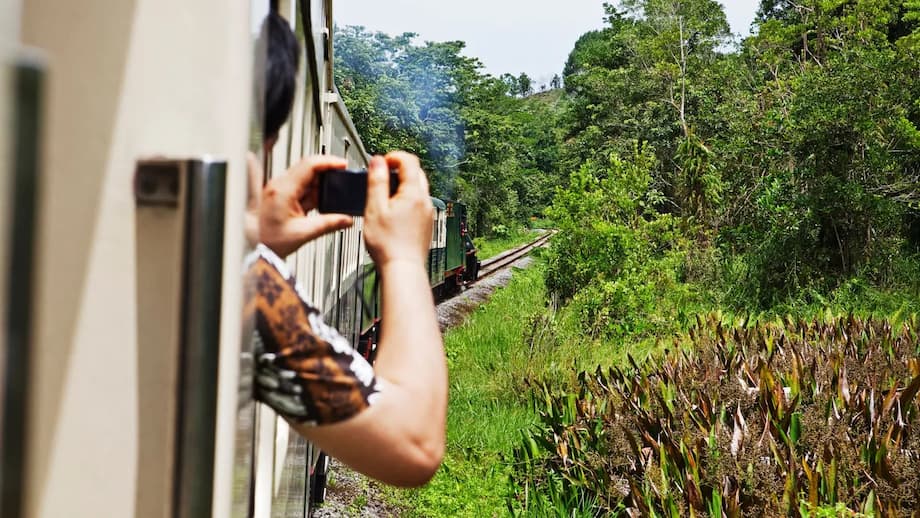Momentum returns to the rails
For decades, Malaysia’s rails were overshadowed by highways and low cost flights. That balance is shifting. From the factories of Kedah and Penang to border towns in Kelantan, trains are moving people and goods with new speed and reach. Intercity ridership has more than doubled in the past decade. Scenic services on the East Coast Line keep remote villages connected. On the busiest corridors, electric trains now link major cities with fewer delays and better comfort.
A raft of projects under national development plans, together with state and federal investments, is rebuilding the backbone of the network. The Electric Train Service, known as ETS, is being extended to Johor Bahru. When the southern stretch is complete, travel between Johor Bahru and Kuala Lumpur is expected to take about three and a half hours on electric trains. Malaysia and Thailand are preparing to restart direct passenger services between Kuala Lumpur and Bangkok. The cross border Shuttle Tebrau that now ferries thousands between Johor Bahru and Woodlands is set to give way to the Rapid Transit System Link in 2026, creating a faster daily commute into Singapore. The momentum, long in the making, is now visible on platforms across the peninsula.
What is driving the comeback
Commuters are finding rail faster and more predictable than clogged roads and intercity buses. Northern commuter services launched in 2015 helped workers in Kedah reach Penang island factories on reliable schedules. Within the Klang Valley, modern metro and LRT lines have pulled riders back, especially as maintenance backlogs clear and more train sets return from overhaul. For intercity travel, ETS trains cut journey times while offering airline style comfort at prices that families and students can afford.
Policy has shifted toward rail to ease road congestion and reduce emissions. New rolling stock is arriving, while older fleets undergo heavy maintenance and overhaul. The government wants to raise railway track utilization in Peninsular Malaysia from about 30 percent today to 80 percent by 2030. Achieving that goal requires more trains, better timetables, and tight coordination between operators across borders.
From diesel era to electrification
Two technical changes sit at the heart of the revival. Double tracking allows trains to pass in opposite directions without waiting, which raises capacity and reliability. Electrification replaces diesel with overhead line equipment that supplies power through a contact wire. Crews must install masts, run cables, tension the wire, energize the system, and test it repeatedly before passenger service can begin. It is meticulous work, and it is the reason upgrades often come online in phases rather than all at once.
ETS expansion to Johor Bahru
South of Gemas, crews are finishing the last electrified stretch to Johor Bahru. The alignment from Segamat to JB Sentral has been under intensive testing, with trial runs on the Segamat to Kluang segment. The most complex work lies between Kluang and JB Sentral, where sections still await full overhead line equipment, signaling, and integration with existing track. Even after the wires go up, each new ETS train set must log thousands of fault free kilometers before carrying paying passengers.
Officials say the extension remains in phased rollout. Electric services already reach Segamat, and more segments will open once safety regulators issue approvals. When the final segment is commissioned, riders can expect fast electric journeys from Johor Bahru to Kuala Lumpur that rival a car trip without the stress of traffic.
In outlining near term goals, KTMB acting chief executive Ahmad Nizam Mohamed Amin said the southern link would transform mobility across the west coast and unlock new travel patterns for Singapore visitors.
‘Once completed, the ETS will connect Johor Bahru to Padang Besar and cut the Johor Bahru to Kuala Lumpur journey to about three and a half hours.’
Timelines and milestones
Staged openings are common when railways are upgraded under traffic. Installing and certifying overhead line equipment can take months because tensioning, electrical safety, and protective relays have to be verified at every section. New train sets must complete type tests and reliability runs. Industry practice often requires at least 8,000 fault free kilometers before a fleet enters service. Each step reduces the risk of teething issues when passengers come on board.
Cross border links return
A web of cross border services is set to return. Malaysia and Thailand have agreed in principle to revive a direct passenger train between Kuala Lumpur and Bangkok. The classic Bangkok to Butterworth service is also being reinstated after a long suspension. These trains once carried leisure travelers, rail enthusiasts, and small traders, linking Penang, Perlis, and southern Thailand in a single itinerary. They will soon do so again, backed by joint ticketing, shared marketing, and common operating procedures.
Transport Minister Anthony Loke has set a clear target for the revival and has asked both railways to prepare for operations.
‘Malaysia and Thailand intend to revive the direct train service between Kuala Lumpur and Bangkok this year. This does not require a new track but does call for coordination, joint marketing, and cooperative ticketing.’
Farther east, Thailand and Malaysia have agreed to reconnect Sungai Kolok in Narathiwat to Rantau Panjang in Kelantan. The link has been dormant since the late 1970s. Service is planned to start in 2026, creating a second border rail crossing on the east coast and enabling direct trips from Kelantan into southern Thailand.
The State Railway of Thailand has signaled an appetite to grow cross border freight alongside passenger links. Ekkarat Sriarayanphong, who heads the governor’s office at the Thai railway, described the agency’s position.
‘SRT is ready to support cross border freight routes, including the Padang Besar to Hat Yai Junction corridor, in collaboration with KTMB.’
Region wide integration also includes cargo. KTMB launched the ASEAN Express, a freight train that can reach Chongqing in China in under two weeks. Customs rules and inspections have slowed expansion, but Malaysian officials are pushing for streamlined procedures. The goal is a reliable rail bridge for goods that is faster than sea and cheaper than air.
Ahmad Nizam said better coordination at borders would unlock major new revenue for freight.
‘If we can overcome the obstacles, we can resume regular freight between Kuala Lumpur and Chongqing and beyond, even as far as Europe.’
The East Coast Rail Link and the east coast corridor
The single largest piece of the puzzle is the East Coast Rail Link, a 665 km artery from Port Klang on the west coast to Kota Bharu in Kelantan. The line will finally bring modern passenger rail to Terengganu and give shippers on the east coast a high capacity route to ports. It will also cut heavy lorry traffic on trunk roads and improve safety.
The project has drawn debate along its route. Some residents blame construction for worsening local flooding, while many town councils expect new stations to lift investment and jobs. Authorities say the line has been redesigned to reduce costs and environmental risks compared with the original proposal. Work continues on stations, tunnels, and the central spine across Pahang.
Policymakers are also weighing an extension from Kota Bharu to Rantau Panjang at the Thai border. Malaysia Rail Link, the project owner, says the idea remains under consideration because a revived KTMB route from Pasir Mas to Rantau Panjang would create a clear right of way. The extension, estimated at about 32 km at roughly 2 billion ringgit, could connect the ECRL directly to Thailand.
A new rail economy is growing around these investments. In Perak, CRRC Malaysia assembles train sets, works with hundreds of local suppliers, and trains a mostly Malaysian workforce. The company sees a long pipeline of projects in mainline rail and urban transit.
CRRC Malaysia general manager Huang Hai described the opportunity as both industrial and social.
‘By providing green, energy saving and modern rail transit equipment, we can help people travel more comfortably and improve the load capacity and speed of railway freight.’
On the east coast, business leaders in towns like Mentakab anticipate a lifeline for local enterprise. Chris Lai, who leads the Chinese Chamber of Commerce in Temerloh district, captured that sentiment.
‘When the new government decided to terminate the East Coast Rail Link project, we were so disappointed. With a new station, young people can come back to their hometowns and build opportunity here.’
Life on the Jungle Railway
Beyond megaprojects, Malaysia’s oldest rail corridor still matters. The East Coast Line, often called the Jungle Railway, threads through dense forest and tin heritage towns. It is a lifeline for students heading to the only secondary school for many miles and for villagers who need access to clinics, markets, and government services.
Tourists ride it for the scenery. Locals ride it because there is no practical substitute. Flood damage on border sections has constrained services toward Thailand, a gap that the Sungai Kolok to Rantau Panjang reconnection aims to close. For communities on this corridor, trains remain the most dependable way to move.
Economic impact across towns and cities
Rail is reshaping local economies in visible ways. In northern Kedah, workers now commute by train to Penang’s industrial zones with shorter journeys than the bus. Towns on the west coast line, from Taiping to Segamat, report new shops and homestays near stations. At Padang Besar on the Thai border, trade and shopping have flourished with frequent rail links.
Intercity trains are often fully booked on holidays. The ETS has opened weekend trips from central Malaysia to tourist hubs like Ipoh and Penang, while also making it easier for Malaysians to reach border towns for shopping and food. On the southern frontier, the Shuttle Tebrau carries millions each year between Johor Bahru and Singapore, and will be replaced by the Rapid Transit System Link for a faster crossing.
These gains depend on rolling stock and maintenance. The Transport Ministry has targeted higher track utilization and has secured more train sets while overhauling existing fleets. Maintenance contracts have returned several ETS and Komuter sets to service, easing crowding and enabling tighter headways on busy lines.
Challenges, costs and capacity
Malaysia’s rail revival comes with constraints. KTMB’s passenger services are subsidized and the operator carries sizable liabilities. Fare policy, freight growth, and better asset use will matter for long term health. The aim to reach 80 percent track utilization by 2030 will require precise scheduling, punctual maintenance, and more drivers and technicians.
On the ETS extension, construction delays and land issues have slowed progress at times. Overhead wiring and modern signaling are complex systems that must be installed and tested in sequence, which limits how quickly service can be introduced. Authorities have promised clearer public communication on timelines as each southern segment reaches trial operations and certification.
Planners also face the long running question of a Kuala Lumpur to Singapore high speed line. The ETS will make Johor Bahru to Kuala Lumpur much faster and more comfortable, yet it is not a full substitute for a true high speed corridor that can carry large volumes of business and leisure travelers at much higher speeds. For now, the policy focus is on strengthening the domestic backbone and knitting together regional links with Thailand, Laos, and China.
The Bottom Line
- ETS expansion to Johor Bahru is rolling out in stages, with trial runs on southern segments and a target journey of about 3.5 hours between Johor Bahru and Kuala Lumpur when complete.
- Intercity rail ridership has more than doubled in the past decade, while urban commuter numbers fluctuated amid maintenance and fleet overhauls.
- Malaysia and Thailand plan to revive direct passenger services between Kuala Lumpur and Bangkok and to bring back Bangkok to Butterworth trains.
- The Sungai Kolok to Rantau Panjang border link is planned to reopen in 2026, creating a second rail gateway on the east coast.
- KTMB’s ASEAN Express freight service aims to connect Malaysia with Laos, Thailand, and China in under two weeks, but customs processes still limit frequency.
- The East Coast Rail Link spans about 665 km and may be extended 32 km to Rantau Panjang, promising stronger east coast connectivity but also drawing environmental concerns.
- The government targets 80 percent railway track utilization by 2030 and is adding new train sets while overhauling existing fleets.
- The RTS Link is set to replace the Shuttle Tebrau in 2026, speeding up daily travel between Johor Bahru and Singapore.




